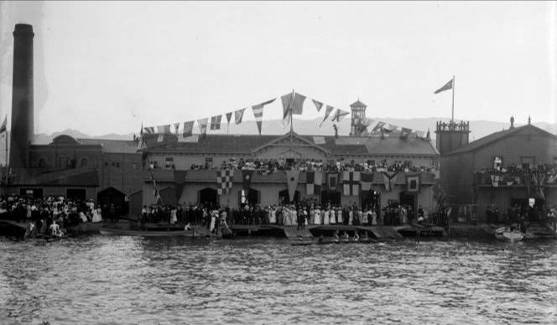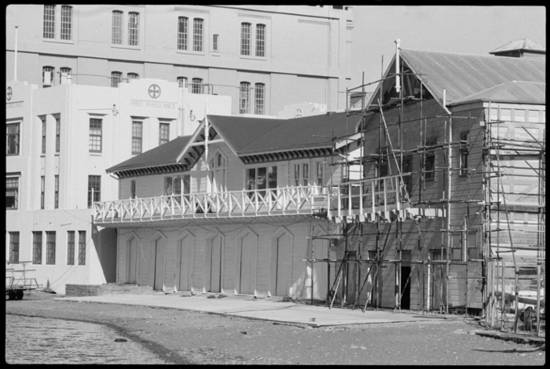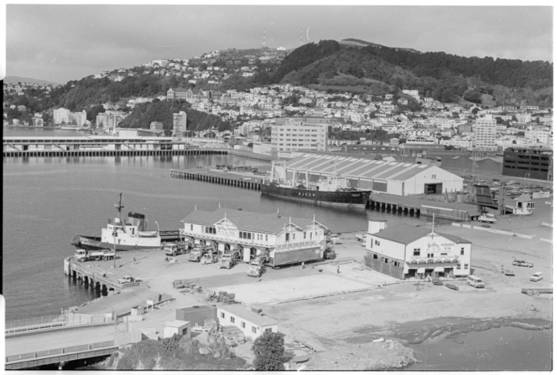Star Boating Club
97 Jervois Quay



National Library reference: Star Boating Club. Field family :Field and Hodgkins family photographs. Ref: PA1-q-089-18-1. Alexander Turnbull Library, Wellington, New Zealand. http://natlib.govt.nz/records/22739732

Star Boating Club in 1888
National Library reference: Star Boating Club, seen from the harbour looking towards Jervois Quay. Halse, Frederick James, d 1936 :Collection of negatives. Ref: 1/2-004072-G. Alexander Turnbull Library, Wellington, New Zealand. http://natlib.govt.nz/records/22517934

Star Boating Club in 1908
National Library reference: Crowd at the opening of the rowing season at the Star Boating Club, Wellington. Smith, Sydney Charles, 1888-1972 :Photographs of New Zealand. Ref: 1/1-019354-G. Alexander Turnbull Library, Wellington, New Zealand. http://natlib.govt.nz/records/22908764

Star Boating Club and Wellington Rowing Club in 1975
National Library reference: Star Boating Club and Wellington Rowing Club, Wellington. Negatives of the Evening Post newspaper. Ref: 1/4-022671-F. Alexander Turnbull Library, Wellington, New Zealand. http://natlib.govt.nz/records/22777000

National Library reference Star Boating Club, Wellington. Further negatives of the Evening Post newspaper. Ref: EP/1989/3286/13-F. Alexander Turnbull Library, Wellington, New Zealand. http://natlib.govt.nz/records/22301295
-
Constructed
1885 - 1886
-
-
Architect(s)
-
Builder(s)
W. Fitzgerald & E. Connal
-
The building was purpose-built for the Star Boating Club, one of New Zealand’s oldest rowing and sporting clubs. The two-storey design had space for storing boats on the ground floor and social areas upstairs.
In 1889 it was moved by steam train for ongoing harbour reclamation. It was moved again in 1989 as part of redeveloping Wellington's waterfront, and extensively refurbished.
Downstage Theatre occupied the clubrooms between 1969 and 1973. As The Boatshed it is now a function centre.
-
Downloadable(s)
-
close
History
-
The Star Boating Club Building on Wellington's waterfront was built specifically for the club in 1886, and the club still occupies this building today.
The Star Boating Club was formed in 1866. It was the first rowing club established in Wellington and is one of the oldest sporting clubs in New Zealand. It was originally formed by whaling boat owners keen on racing, and whale boats remained in club competitions until well into the 20th century. Initially, the club was housed in a shed erected near the site of the Cenotaph, but harbour reclamation and the resulting loss of their waterfront position resulted in the club relocating to another shed in 1874. Further reclamations during 1883 meant that the club needed to move again. This led to the construction of the Star Boating Club Building.
The Star Boating Club Building was purpose built for the club. It was designed by architect William Chatfield, himself a club member. Given that the club's previous boatsheds had been affected by harbour reclamations, the new building was built on skids so that it could be relocated easily. It was erected in 1886 and was originally sited on Customhouse Quay on land which was reclaimed, this project being paid for by club members. The building was constructed by W. Fitzgerald and E. Connal, and the two storey design provided space for storing boats on the ground floor and social areas upstairs.
Only three years later, in 1889, it became necessary to move the clubrooms due to ongoing harbour reclamations. The building was moved by steam engine to the site on Jervois Quay it then occupied for 100 years. It is possibly the only building in New Zealand relocated in this way. It was later joined there by the Wellington Rowing Club building, Odlins Building and later still, in 1932, by the Wellington Free Ambulance Building.
The club was once possibly the largest athletic club in the Southern Hemisphere, boasting 390 members prior to World War One. Founded by H.F. Logan, J.C. Boddington and R. Kirton, among others, the Star Boating Club has had a number of prominent members, including Olympic athlete George Cooke and former Governor General and recipient of the VC, Lord Freyberg. In 1945, the exterior of the eastern end of the building was slightly damaged by fire, and the clubrooms were renovated the same year. In 1965, the building was renovated in time for the Star Boating Club's centennial celebrations.
The building has also played an important part in the history of the Downstage Theatre, New Zealand's longest running professional theatre, who occupied the clubrooms between 1969 and 1973. During that time modifications were made to the upper storey of the building, while the rowing club continued to operate from the ground floor. During Downstage's time in the building performers included many of New Zealand's most successful actors. The motivation to rent the building to Downstage was to raise funds in order to build new clubrooms, as the prospect of demolishing the building and relocating the club had been discussed by the Council and the club for some time. In the end, the club lobbied against relocation and instead undertook renovations to the clubhouse in order to meet council requirements.
However, in 1989 the building was relocated to its present site as part of the redevelopment of Wellington's waterfront, and was extensively refurbished, including replacing the skids with a new foundation. For the first time in its existence the building faced the city rather than the sea. The Wellington Rowing Club building was also relocated, maintaining the close relationship between the buildings and clubs themselves. The Star Boating Club Building has since been used as an events venue and as such it has had a significant association with cultural life in Wellington. Events held there have included the 1992 Fringe Festival, the 1993 Gay and Lesbian Devotion Festival, and the International Festival of the Arts in 1994 and 1996. It also continues to be a popular venue for weddings, conferences and other functions. Now on its third site, the building retains its original purpose as the clubrooms for the Star Boating Club. The club continues to attract rowers and has close links with secondary school rowing.
While rowing was a popular sport, only a few of the older boatsheds remain. The Canterbury Rowing Club's building, along with those the other Christchurch rowing clubs had on the river Avon are no longer standing. In Auckland, the original St George's Rowing Club building no longer remains. Currently there are only two boatsheds included on the New Zealand Historic Places Trust Register, the Wellington Rowing Club and the Wanganui Rowing Club. The Wellington Rowing Club was not a purpose built clubrooms and the Wanganui Rowing Club now functions as a museum. The Star Boating Club Building is older than both these buildings and it is the only one to have had a continuous association with rowing.
-
Modifications
close
Not assessed
-
Occupation History
close
Not assessed
-
-
close
Architectural Information
-
Building Classification(s)
close
Not assessed
-
Architecture
close
The Star Boating Club is a simple rectangular building of two stories, with a plain balcony on the first floor facing the lagoon. The design is straightforward and unpretentious, with a subtle yet distinct nautical flavour. The roof consists of two long paired gables, with a central small gable in the middle of each long elevation. Each gable is capped with a finial and the projecting eaves are studded with wooden brackets. The gable form is echoed in the boat-shed doorways on the ground floor. The rhythm of these openings is a simple and effective one.
The Star Boating Club building was purpose built to be relocated as harbour reclamation occurred. It was built on skids to facilitate easy relocation by steam engine.
The Star Boating Club is of architectural significance. It is the work of prominent Wellington architect, and club member, William Chatfield who showed an astute grasp of the requirements for its design so that it continues to be suited to its purpose after a significant length of time. The building has value for its unique design as a boatshed and pavilion. It combines nautical themes and a lively and picturesque view with a structure devoted to the particular needs of its users. The ultimately vital design-to-move structure through the use of skids is a specific design solution that showed an understanding of future pressures. The large open ground floor interior of structural timber is practical and spare but has the appealing patina of long use. The Star Boating Club has value for its exterior design. Despite being essentially a large shed, the building is striking for its rhythm and symmetry in the pattern of doors and windows. These features, along with its gables and balconies, were designed to give an eye-catching appeal of a domestic scale and allow the large shed to dazzle or impress.
-
Materials
close
The construction is timber, with rusticated weatherboards and a corrugated iron roof. Timbers used in the construction include kauri, heart matai and other indigenous heart timbers.
-
Setting
close
The Star Boating Club Building occupies a prominent place on the Wellington waterfront. This building, along with the neighbouring Wellington Rowing Club, have strong associations for Wellingtonians and provide a visible reminder of Wellington's long standing connections with the harbour. The distinctive Star Boating Club Building and its decorative features contribute greatly to the streetscape in the surrounding area and is a defining building of the harbour coastline.
-
Building Classification(s)
close
-
close
Cultural Value
The Star Boating club building has architectural and technological significance as it was specifically designed by the eminent architect William Chatfield to facilitate its relocation, responding to the ongoing reclamation of Wellington's waterfront.
The building has high historical significance given its continuous association with the Star Boating Club, one of the oldest rowing and sporting clubs in New Zealand. The building has also had a significant historical association with New Zealand's longest running professional theatre, Downstage.
This distinctive building contributes greatly to the streetscape and, along with the neighbouring Wellington Rowing Club building occupies a prominent place on the waterfront.
-
Aesthetic Value
close
-
Architectural
Does the item have architectural or artistic value for characteristics that may include its design, style, era, form, scale, materials, colour, texture, patina of age, quality of space, craftsmanship, smells, and sounds?
The Star Boating Club is a fine example of a Victorian boating clubhouse. It is one of only a few purpose-built boating club buildings in New Zealand to have survived into the 21st century, and the only one that remains in its original use.
-
Group
Is the item part of a group of buildings, structures, or sites that taken together have coherence because of their age, history, style, scale, materials, or use?
The building has group value for its association with other heritage buildings, particularly the Wellington Rowing Club Building, and also including Odlin’s and the Wellington Free Ambulance Building.
-
Townscape
Does the item have townscape value for the part it plays in defining a space or street; providing visual interest; its role as a landmark; or the contribution it makes to the character and sense of place of Wellington?
This building, along with the neighbouring Wellington Rowing Club, forms an important element in the Wellington waterfront alongside Frank Kitts Park.
-
-
Historic Value
close
-
Association
Is the item associated with an important historic event, theme, pattern, phase, or activity?
The club is the oldest sporting club in Wellington, and one of the oldest sporting clubs in New Zealand. It is also the third oldest rowing club in New Zealand. Rowing was a popular sport and the club was once likely to have been the largest athletic club in the Southern Hemisphere.
During the First and Second World Wars the building also played an important role in the community, becoming the base for a number of groups such as the St. Johns Ambulance Brigade, the Red Cross and various patriotic committees.
-
Association
Is the item associated with an important person, group, or organisation?
The Star Boating Club Building is of outstanding historical significance for several reasons. The club has operated continuously since 1866 and has been associated with this building since it was purpose built for the club in 1886.
It has also had a significant association with the Downstage Theatre, New Zealand's longest running professional theatre company. While operating out the Star Boating Club a large number of notable New Zealand actors performed for Downstage.
-
-
Scientific Value
close
-
Archaeological
Does the item have archaeological value for its ability to provide scientific information about past human activity?
Reclamation
-
Technological
Does the item have technological value for its innovative or important construction methods or use of materials?
The Star Boating Club building is of technological significance as it was purpose built to be relocated as harbour reclamation occurred. It was built on skids to facilitate easy relocation and was relocated by steam engine only three years after its original construction. It is likely to be the only building in Wellington designed to be relocated in this way, and it is probable that is the only building in New Zealand to have been transported in this way. When the building was relocated for a second time, in 1989, the skids were replaced by a new foundation. Although the skids have been replaced, the building retains its technological value for the foresight and practicality of this design feature.
-
-
Social Value
close
-
Identity/Sense of place/Continuity
Is the item a focus of community, regional, or national identity? Does the item contribute to sense of place or continuity?
Despite many alterations, and its removal to a new site in the early 1990s, the building has been a key element on Wellington’s waterfront for over 120 years and contributes to the sense of place and continuity of the waterfront recreational precinct.
-
Public Esteem
Is the item held in high public esteem?
The building is likely to be held in high public esteem as it is an attractive, picturesque building set within the recreational zone of the Wellington Waterfront.
-
Sentiment/Connection
Is the item a focus of community sentiment and connection?
The Star Boating Club building is of social significance as the clubrooms for the Star Boating Club. Club members have included prominent New Zealanders such as Lord Freyberg and Olympic athlete George Cooke. In addition to this the building is also significant as it has been the venue for prominent cultural events, such as the International Festival of Arts, the Fringe Festival and the 1999 and 2000 NZ TV2 Laugh Festival. The building is also of value for its use to the community, having been used by numerous other clubs and community groups since the First World War. It continues to be used as a popular venue for weddings and other events and was also the venue for one of NZ's first Civil Unions immediately following adoption of the Civil Union Bill by Parliament, at which the Mayor of Wellington was the celebrant.
-
-
Level of Cultural Heritage Significance
close
-
Authentic
Does the item have authenticity or integrity because it retains significant fabric from the time of its construction or from later periods when important additions or modifications were carried out?
Despite being relocated several times and renovated, this building retains a high level of authenticity.
-
Rare
Is the item rare, unique, unusual, seminal, influential, or outstanding?
The Star Boating Club Building is rare in that it is one of the only boatsheds of its age that continues to be used by its founding club, and as such is part of New Zealand's sporting heritage.
Along with its companion, the Wellington Rowing Club, this building is a notably rare central city timber building.
-
Importance
Is the item important for any of the above characteristics at a local, regional, national, or international level?
The building is nationally significant due to its rarity.
-
-
Local / Regional / National / International Importance
close
Not assessed
-
Aesthetic Value
close
-
close
Site Detail
-
District Plan Number
17/ 285
-
Legal Description
Lots 201 202 206 207 DP 67374
-
Heritage New Zealand Listed
1/ Historic Place 1431
-
Archaeological Site
Reclaimed land
-
Current Uses
unknown
-
Former Uses
unknown
-
Has building been funded
No
-
Funding Amount
Not applicable
-
Earthquake Prone Status
124 Notice
-
-
close
Additional Information
-
Sources
close
- Cyclopedia Co. Ltd, “Chatfield, William Charles,” in The Cyclopedia of New Zealand: Wellington Provincial District (Wellington: The Cyclopedia Company Limited, 1897), accessed January 28, 2013
- “District Plan: Heritage building – Star Boating Club & Wellington Rowing Club”, 1999, 1041-06-STA Vol. 1, Wellington City Council Records.
- Historic Places Trust, “Chatfield, William Charles”, Professional Biographies, accessed January 28 2013,
- Searle, Chloe, and Alison Dangerfield, Star Boating Club Building, Historic Places Trust website, 2009,
- Wellington City Council, “Taranaki Street Wharf: Star Boating Club,” Wellington Heritage Building Inventory 2001: Non-Residential Buildings. (Wellington City Council, 2001), TARAW2.
- Wellington City Council, “Appendix III”, Wellington Heritage Building Inventory 2001: Non-Residential Buildings. (Wellington City Council, 2001).
- Technical Documentation close
-
Footnotes
close
Not available
-
Sources
close
Last updated: 11/23/2016 9:34:45 PM
